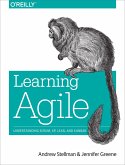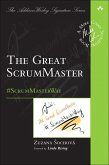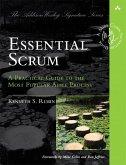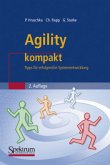In the past few years the Project Management Institute (PMI) has been introducing agile methods to project managers in all industries. When software development project teams move to agile methodologies, their project managers are often left feeling as if they've been cast aside. Traditionally trained project managers remain wondering what their new roles and responsibilities should be in an environment that no longer needs them to make stand-alone decisions. This book, The Software Project Manager's Bridge to Agility, focuses on redefining the job of the software project manager so as to support Agile's self-organizing team environment. Special emphasis is placed on the shift to servant leadership, with its focus on facilitation and collaboration. Mapping of the Project Management Institute's (PMI) Project Management Body of KnowledgeR (PMBOK) best practices to agile practices is discussed at length. After reading this book, project managers should have a better understanding of what changes they need to make professionally and how to make these changes to survive the transition to an agile software development approach. Preface Part I An Agile Overview Chapter 1 What is Agile? Chapter 2 Mapping from the PMBOKR Guide to Agile Chapter 3 The Agile Project Lifecycle Part II The Bridge: Relating PMBOKR Guide Practices to Agile Practices Chapter 4 Integration Management Chapter 5 Scope Management Chapter 6 Time Management Chapter 7 Cost Management Chapter 8 Quality Management Chapter 9 Human Resources Management Chapter 10 Communications Management Chapter 11 Risk Management Chapter 12 Procurement Management Part III Crossing the Bridge to Agile Chapter 13 How Will My Role as a Project Manager Change? Chapter 14 How Will I Work with Other Teams Who Aren't Agile? Chapter 15 How Can a Project Management Office Support Agile? Chapter 16 Selling the Benefits of Agile Chapter 17 Common Mistakes Appendix A Agile Methodologies Appendix B Typical Agile Artifacts Glossary Bibliography Index
When software development teams move to agile methods, experienced project managers often struggledoubtful about the new approach and uncertain about their new roles and responsibilities. In this book, two long-time certified Project Management Professionals (PMPRs) and Scrum trainers have built a bridge to this dynamic new paradigm. They show experienced project managers how to successfully transition to agile by refocusing on facilitation and collaboration, not command and control.
The authors begin by explaining how agile works: how it differs from traditional plan-driven methodologies, the benefits it promises, and the real-world results it delivers. Next, they systematically map the Project Management Institute's classic, methodology-independent techniques and terminology to agile practices. They cover both process and project lifecycles and carefully address vital issues ranging from scope and time to cost management and stakeholder communication. Finally, drawing on their own extensive personal experience, they put a human face on your personal transition to agile--covering the emotional challenges, personal values, and key leadership traits you'll need to succeed.
Coverage includes
Relating the PMBOKR Guide ideals to agile practices: similarities, overlaps, and differencesUnderstanding the role and value of agile techniques such as iteration/release planning and retrospectivesUsing agile techniques to systematically and continually reduce riskImplementing quality assurance (QA) where it belongs: in analysis, design, defect prevention, and continuous improvementLearning to trust your teams and listen for their discoveriesProcuring, purchasing, and contracting for software in agile, collaborative environmentsAvoiding the common mistakes software teams make in transitioning to agileCoordinating with project management offices and non-agile teamsSelling agile within your teams and throughout your organization
For every project manager who wants to become more agile.
Part I An Agile Overview 7
Chapter 1 What is "Agile"? 9
Chapter 2 Mapping from the PMBOKR Guide to Agile 25
Chapter 3 The Agile Project Lifecycle in Detail 37
Part II The Bridge: Relating PMBOKR Guide Practices to Agile Practices 49
Chapter 4 Integration Management 51
Chapter 5 Scope Management 67
Chapter 6 Time Management 83
Chapter 7 Cost Management 111
Chapter 8 Quality Management 129
Chapter 9 Human Resources Management 143
Chapter 10 Communications Management 159
Chapter 11 Risk Management 177
Chapter 12 Procurement Management 197
Part III Crossing the Bridge to Agile 215
Chapter 13 How Will My Responsibilities Change? 217
Chapter 14 How Will I Work with Other Teams Who Aren't Agile? 233
Chapter 15 How Can a Project Management OfficeSupport Agile? 249
Chapter 16 Selling the Benefits of Agile 265
Chapter 17 Common Mistakes 285
Appendix A Agile Methodologies 295
Appendix B Agile Artifacts 301
Glossary 321
Bibliography 327
Index 333
When software development teams move to agile methods, experienced project managers often struggledoubtful about the new approach and uncertain about their new roles and responsibilities. In this book, two long-time certified Project Management Professionals (PMPRs) and Scrum trainers have built a bridge to this dynamic new paradigm. They show experienced project managers how to successfully transition to agile by refocusing on facilitation and collaboration, not command and control.
The authors begin by explaining how agile works: how it differs from traditional plan-driven methodologies, the benefits it promises, and the real-world results it delivers. Next, they systematically map the Project Management Institute's classic, methodology-independent techniques and terminology to agile practices. They cover both process and project lifecycles and carefully address vital issues ranging from scope and time to cost management and stakeholder communication. Finally, drawing on their own extensive personal experience, they put a human face on your personal transition to agile--covering the emotional challenges, personal values, and key leadership traits you'll need to succeed.
Coverage includes
Relating the PMBOKR Guide ideals to agile practices: similarities, overlaps, and differencesUnderstanding the role and value of agile techniques such as iteration/release planning and retrospectivesUsing agile techniques to systematically and continually reduce riskImplementing quality assurance (QA) where it belongs: in analysis, design, defect prevention, and continuous improvementLearning to trust your teams and listen for their discoveriesProcuring, purchasing, and contracting for software in agile, collaborative environmentsAvoiding the common mistakes software teams make in transitioning to agileCoordinating with project management offices and non-agile teamsSelling agile within your teams and throughout your organization
For every project manager who wants to become more agile.
Part I An Agile Overview 7
Chapter 1 What is "Agile"? 9
Chapter 2 Mapping from the PMBOKR Guide to Agile 25
Chapter 3 The Agile Project Lifecycle in Detail 37
Part II The Bridge: Relating PMBOKR Guide Practices to Agile Practices 49
Chapter 4 Integration Management 51
Chapter 5 Scope Management 67
Chapter 6 Time Management 83
Chapter 7 Cost Management 111
Chapter 8 Quality Management 129
Chapter 9 Human Resources Management 143
Chapter 10 Communications Management 159
Chapter 11 Risk Management 177
Chapter 12 Procurement Management 197
Part III Crossing the Bridge to Agile 215
Chapter 13 How Will My Responsibilities Change? 217
Chapter 14 How Will I Work with Other Teams Who Aren't Agile? 233
Chapter 15 How Can a Project Management OfficeSupport Agile? 249
Chapter 16 Selling the Benefits of Agile 265
Chapter 17 Common Mistakes 285
Appendix A Agile Methodologies 295
Appendix B Agile Artifacts 301
Glossary 321
Bibliography 327
Index 333








